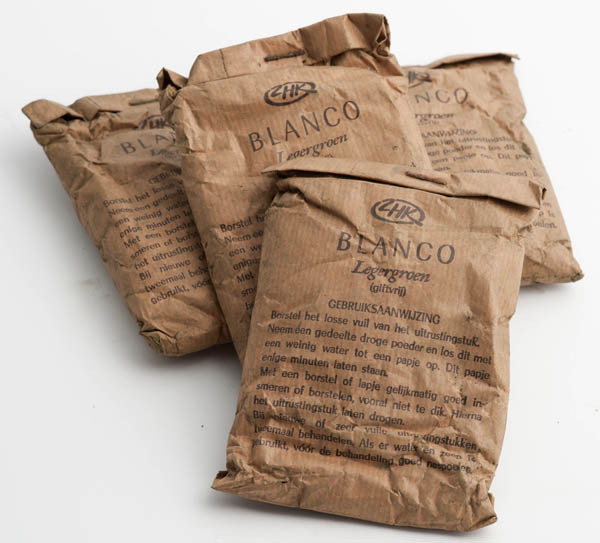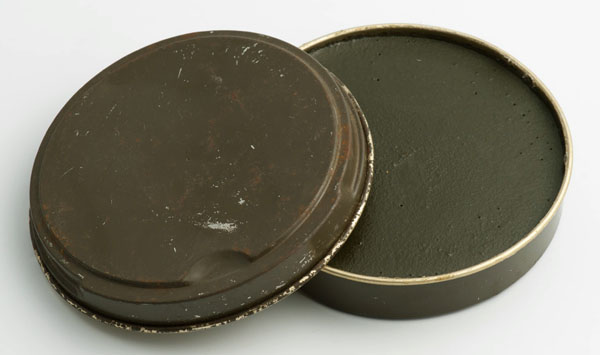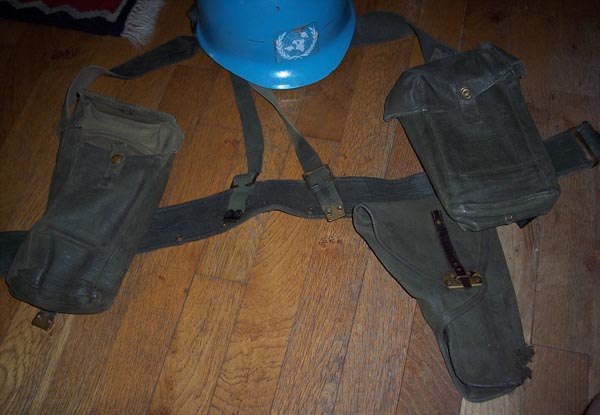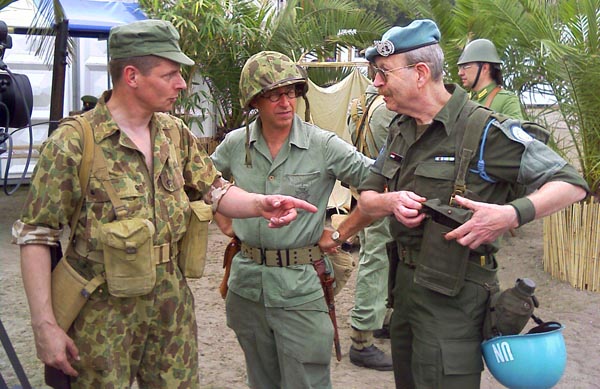Dutch post WWII webbing cleaner

Photo: David Pratt
StigRoadie writes: Post war Dutch powdered blanco. Looks more ‘green’ to me than KG3
Pack reads:
ZHK
BLANCO
Legergroen
(giftvrij)
GEBRUIKSAANWIJZING
Borstel het losse vuil van het uitrustingstuk. Neem een gedeelte droge poeder en los dit met een weinig wter tot een papje op. Dit papje enige minuten laten staan.
met een borstel of lapje gelijkmatig goed insmeren of borstelen, vooral niet te dik. Hierna het uitrustingstuk laten drogen.
Bij nieuwe of zeer vuile uitrustingstukken tweemaal behandelen. Als er water en zeep is gebruikt, voor de behandeling goed naspoelen.
English translation:
ZHK
BLANCO
Army Green
(non-toxic)
INSTRUCTIONS
Brush loose dirt from the equipment.
Take some dry powder and dissolve with a little water to make a paste. Let the paste stand for some minutes.
With a brush or rag rub or brush on evenly, especially not too thick. Let the piece of equipment dry after application.
With new or very dirty pieces of equipment treat twice. If water and soap is used, rinse well before treating.
Thomas Milo (from the Netherlands and in 44 armoured infantry battalion in the early 1980’s): “This was RNLA (Royal Netherlands Army) standard issue blanco to treat our British-derived webbing equipment in the 1980’s. There were similar brown tins with shoe polish. I still have several of such green and brown tins. In the early 1980’s blancoing of webbing was abolished as new dark green webbing was introduced (replacing the light khaki that were “painted” dark green with a thick layer of blanco) that were supposed to be less visible in infrared.”
‘Stig Roadie’, who has contributed a lot of material on the ‘Blanco’ side of this website, has found it for sale in a French army surplus shop and they suggested the product (in brown and green) was for polishing shoes. “I popped into the Doursoux shop in Paris again today. They still have this tinned stuff in green and brown. With their English and my rubbish French they were sure it is French Army issue and is shoe polish. When I asked was it not for the belt or equipment I got a laugh, no, they said, pour chaussures.”

Photo: David Pratt
http://www.41dko.nl/index.php?id=237

A – M-58 “brass” kit (koper) – like the original British webbing, lots of polishing was mandatory; this also is the kit that still required intensive blancoing, allegedly to improve camouflage:
http://www.41dko.nl/index.php?id=25
B – The M-76-78 “Black” kit – the brass parts are now factory painted black, no more polishing and a ban on applying blanco, as it would break infra-red camouflage:
http://www.41dko.nl/index.php?id=26
C – The late 1980’s “PlayMobil” kit for the last few years until the end of the cold war – the majority of the pieces were now made from some sort of plastic. It seems no body was bothered by camouflage anymore.
http://www.41dko.nl/index.php?id=257
All generations are interchangeable and in the early 1980’s elements of the first two generations frequently mixed: I had brass (A) and black (B) pieces, and we all had early “Playmobil” (C) entrenching tools.
All types A, B and C are semi-“americanised” by adding holes at the lower part of the belt, necessary to attach the US style water bottle and entrenching tool. We also had a hybrid British style holsters for the FN Browning pistol, with clamps to fit in the “american” holes for attaching. The “playmobil” holsters that later replaced them were so stiff and useless that I repossessed my battle-worn old typ A webbing holster and kept it for the duration. Since it had been scrapped already, I managed to keep it.

Photo: Thomas Milo
In the next picture, taken on the yearly Veterans’ Day in The Hague, you can see me dressed up in my old kit explaining to a re-enactor (of the 1945-49 Dutch East Indies campaign) that the Royal NL Army went to Lebanon 30 years later with practically the same webbing equipment. The re-enactor in the middle represents the Royal NL Marines of the same period, trained and equipped by the US Marine Corps, originally to fight the Japanese. You can see that his bayonet is attached in the same manner as my water bottle. With standard British webbing that would be impossible.

Photo: Thomas Milo
